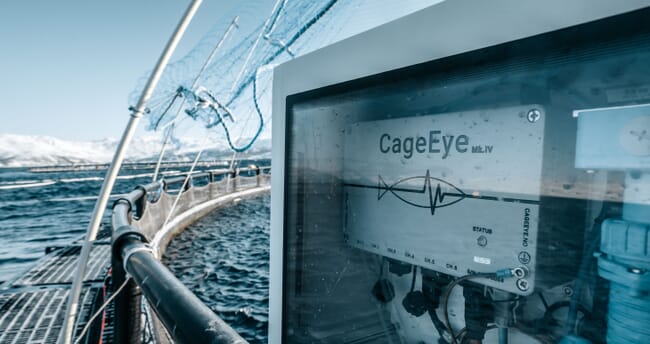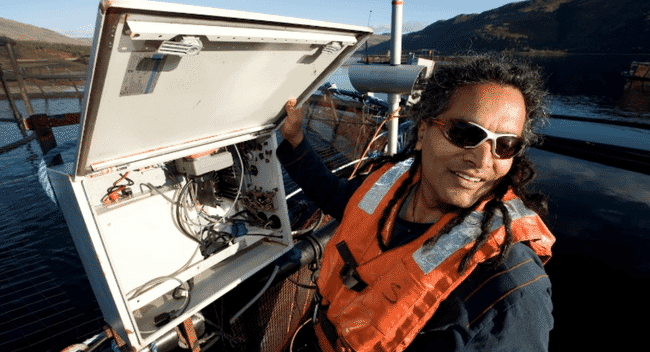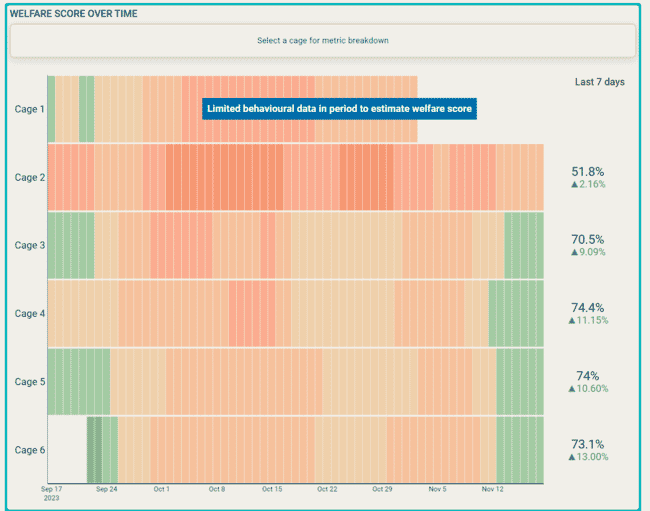
The first new versions of the systems, which were released this year, have been installed on salmon farms in Norway and Chile © CageEye
Can you give a brief overview of the company?
The company was founded 10 years ago to commercialise a hydroacoustic sensor that had been developed in the 1980s for research purposes. Since that time, the company and the products have gone through several iterations, but has now settled into a path of consolidation, with a hardware offering of hydroacoustic sensors which can monitor the behaviour of the fish population, facilitating software offerings which employ AI and deep learning to provide automated feeding (Echofeeding), as well as feeding and welfare analytics (Discovery).
What makes its products unique?
Monitoring fish in cages has traditionally been done with cameras, and while these are incredibly useful, they are limited in their ability to provide information from the whole cage/fish population, as well as in the dark, or conditions of poor visibility (the latter being something that is becoming more and more commonplace).
It should be noted, however, that the tech is not aiming to replace cameras, but to provide a complementary offering, which significantly enhances fish farming operations.
What appeals about the business to you?
I’m a fish behaviourist, I did my PhD on salmon behaviour on farms, and have been involved in salmon welfare research since its beginnings; I was also part of the company that had the first success in providing autonomous demand feeding in cages (back in the 1990s) – the farming systems eventually outgrew that technology, and no one has managed to emulate our previous success since.
With CageEye’s technology having the potential to do just that, as well as to monitor welfare status, and even predict diseases well before they are currently diagnosed, it falls right in my areas of technical, biological and commercial interest, and of course offers a solution to some major problems out there in the market.

How widely adopted has the technology been to date?
The newest technology offerings, which have only been rolled out this year, are being used by a few Norwegian salmon producers along with one in Chile; however, demand is good, and the order books are full through 2024.
How do current health challenges in the salmon sector affect the relevance of (and affordability of) CageEye’s technology?
Health challenges in the salmon sector continue to grow, with infectious diseases being a major issue, causing production losses. Being able to monitor (health and) welfare status of the fish allows mitigating actions to be deployed where appropriate.
For example, we now know it can take a lot longer for salmon to recover from mechanical sea lice treatments than previously thought and – as feeding is naturally a stressful experience – holding off on feeding until the right time will provide for better health management of the stock.
In terms of affordability, CageEye’s offerings are provided on a rental basis, so use OpEx budgets rather than CapEx, and with fish health becoming a larger and larger part of production cost, the potential RoI [return on investment] in reducing this increases too.

It uses a AI/deep learning model that combines group swimming behaviour, together with feeding response and environmental parameters, and picks out deviations from "normal" on a per cage basis, in order to indicate the overall welfare status of the fish. The user can click on a cage to establish which parameters are contributing most toward the status as modelled - green denotes good welfare indicators, dark red denotes less positive ones.
Are the products useable in offshore and RAS farms?
The technology has been used to monitor fish behaviour in some of the demo offshore cages that have been seen in the news, and most recently was used to determine whether salmon were managing to fill their swim bladders when using a funnel cage (they were!); so yes to offshore, and funnel cages. They’ve also been used in quite shallow cages in Chile.
However, in it’s current form, the system does not lend itself to use in tanks or ponds. For use in such systems, where there are solid surfaces that sound will bounce off, as well as ambient sounds and bubbles, modifications will be required.
What have been the company’s major milestones to date?
In 2022 CageEye signed the contract for WelfareShield, an EU co-funded project developing a system to provide 24/7 welfare monitoring for salmon in cages, enabling hardware and software development; and hired a Chilean country manager. In 2023 a new CEO was hired, and development was completed on the new generation of hardware, and the first iterations of the new software offerings: Echofeeding and Discovery. In 2024 a new investment round was completed, enabling roll-out of these new developments.
What are the challenges that it’s still working to overcome?
The pains of scaling are many, especially for a tech company, a huge one having been integration with the feeding systems in the market, and their new software iterations. This is even more challenging given the customers’ increased cybersecurity systems. Some of this is being overcome through partnership, and the rest through good hard work by the team.
How do you see the company evolving in the next 3-5 years?
The company will continue to expand, and over that timescale I’d expect to see its products in all salmon markets, and hopefully it’ll be sniffing at the new species horizon too!
How is CageEye related to Bluegrove?
CageEye was the original name of the company, while the move to Bluegrove was a corporate rebranding exercise, as the board and CEO of the time had ambitions whereby the CageEye offering would be one part of a much larger group of technologies on offer under the Bluegrove umbrella. That strategy has long since been abandoned, we have a new board and CEO, and as the original company name had retained great brand recognition in the market, and speaks more to what the tech actually does (though being acoustic-based I’d argue that it’s more of an “ear in the cage” than an eye!), it was decided to go back to CageEye. Hopefully that clears up any confusion out there!




